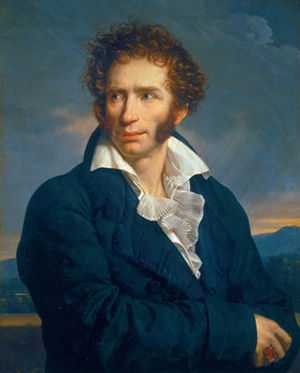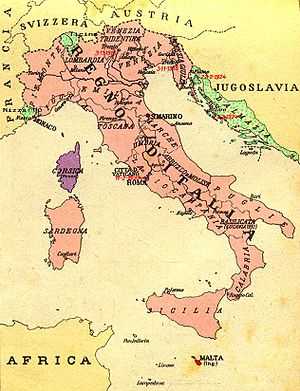Italian irredentism in the Ionian islands

Italian irredentism in the Ionian islands was the only irredentism supported by Italian nationalists in Greece territory during Fascism.
Characteristics
This irredentism was promoted only during Benito Mussolini's dictatorhip, and was mainly related to the island of Corfu. This island, that was the northernmost of the Ionian islands, had a small population still speaking Venetian since the fall of the Republic of Venice in 1797. Even if greatly diminished in number and importance, the Corfiot Italians in the 1930s were supported by the growing nationalism of Musssolini's Italy.
Indeed when Venice ruled Corfu and the other Ionian islands during the Renaissance and until the late 18th century, most of the Corfiote and Ionian upper classes spoke Italian (or Venetian in many cases) and converted to Roman Catholicism, but the mass of people remained Greek ethnically, linguistically, and religiously before and after the Ottoman sieges of the 16th century. Corfiot Italians were mainly concentrated in the city of Corfu, which was called "Città di Corfù" by the Venetians. More than half of the population of Corfu city in the 18th century was Venetian-speaking.[1]
The re-emergence of Greek nationalism after the Napoleonic era, contributed to the disappearance of the Corfiot Italians (and the few Italians of the Ionian islands, like the family Foscolo in Zante). Corfu was incorporated into Greece in 1864. The Greek government abolished all Italian schools in the Ionian islands in 1870, and as a consequence, by the 1940s there were only four/five hundred Corfiote Italians left.[2]
Corfiot Italians and the Risorgimento
The Italian Risorgimento began in the Italian peninsula with the surrounding continental areas (Istria, Dalmatia, Trentino, Nizzardo, etc.) and did not reach Corfu and the Ionian islands. One of the main heroes of the Italian Risorgimento, the poet Ugo Foscolo, was born in Zante from a noble Venetian family of the island, but only superficially promoted the possible unification of the Ionian islands to Italy.
The first newspaper of Corfu was in Italian: the official weekly newspaper (Gazzetta degli Stati Uniti delle Isole Jone) was first published in 1814. First in Italian, then in both Greek and Italian, finally from 1850 in Greek and English; and it continued for the entire duration of the English Protectorate until 1864.
According to historian Ezio Gray, the small communities of Venetian-speaking people in Corfu were mostly assimilated after the island became part of Greece in 1864 and especially after all Italian schools were closed in 1870.[3]
However, the Italian language maintained some importance, as can be seen by the fact that poets like Stefano Martzokis (Marzocchi was the surname of the father, an Italian from Emilia-Romagna) and Geranimos Markonos, the first from Corfù and the second from Cefalonia, wrote in Italian some of their poems in the second half of the 19th century.
The island of Corfu was a refuge for many Italians in exile during the Wars of Independence of Italy, like Niccolò Tommaseo (who married Diamante Pavello-Artale, a Corfiot Italian).[4]
After World War I, however, the Kingdom of Italy started to apply a policy of expansionism toward the Adriatic area and saw Corfu as the gate of this sea. Mussolini developed an extreme nationalistic position in accordance to the ideals of Italian irredentism and actively promoted the unification of Corfu to Italy.
The Corfiote Italians, even if reduced to a few hundreds in the 1930s, were strongly supported by Fascist propaganda and in the summer of 1941 (after the Italian occupation of the Ionian islands) Italian schools were reopened in Corfu city.[5] During World War II Mussolini promoted an initial development of Italian irredentism in Corfu, similar to the one being promoted in Savoy.[6]
After World War I, Italy had embarked on a policy of expansionism towards the Adriatic, in which Corfu played an important role, as it controlled entrance to it. As shown by the incident of 1923, Mussolini and Italian irredentism had set their sights firmly on the island. The Italian community was an especially useful tool, and it was both supported and exploited by Fascist propaganda.[5]
World War II
After the Battle of Greece, the Italians occupied the bulk of the Greek mainland and most of the islands in 1941. Although several proposals for territorial annexation had been put forward in Rome, none were actually carried out during the war. This was due to pressure from the King of Italy, Victor Emmanuel III, and from the Germans, who were concerned of further alienating the Greek population, which was already strongly opposing the Bulgarian annexations in Macedonia and Thrace.

Nevertheless in the Ionian Islands, long a target of Italian expansionism, the Greek civil authorities were replaced by Italians in preparation for a post-war annexation. Indeed during the Second World War Mussolini wanted to possess the Ionian Islands: the Italians occupied Corfu and the Ionian islands from 28 March 1941. They implemented a process of Italianization, with creation of Italian schools, centered around the small surviving community of the Corfiote Italians, who still spoke the Venetian dialect,[7] but which by that time numbered only 500 people, living mainly in Corfu city.[8]
Furthermore Epirus, the area near the Albanian border where a significant Albanian minority (the Cham Albanians) lived, was claimed by Albanian irredentists as "Chameria". Before the war, a great part of Italian propaganda against Greece had revolved around the Chameria issue, as the Italians hoped to gain Albanian support by promoting irredentism in Chameria and Kosovo.[9] Although the Italians wanted to annex Chameria to Albania (that was in personal union to the Kingdom of Italy, in a somewhat way similar to Wales and the United Kingdom of Great Britain), the Germans vetoed the proposal. An Albanian High Commissioner, Xhemil Dino, was appointed, but his authority was limited, and for the duration of the Occupation, the area remained under direct control from the Axis military authorities in Athens.[10]
Another case of Italian-sponsored puppet states on Greek territory were the proposed Aromanian Principality of the Pindus with the Grand Voivodeship of Macedonia, statelets that were to encompass areas of the regions of West Macedonia, northern Thessaly and Epirus,[11] and headed by Alchiviad Diamandi, Nicolau Matoussi and Count Gyula Cseszneky. Many of the autochtonous Aromanian population however refused to collaborate and the "principality" never amounted to much beyond Diamandi's followers, the so-called Roman Legion.[12] With the growth of the Greek Resistance in 1943 and the collapse of their Italian sponsors in September 1943, the plans for the Principality were conclusively shelved.
In summer 1942 Cesare Maria De Vecchi (governor of the Italian Dodecanese from 1936 to 1940) studied the possibility of creating an "arch" of Italian islands, stretching from the Ionian islands to Crete and to Rodi. These island would be annexed to the proposed Greater Italy, to be created after the Axis victory in World War II.
Until September 1943 the population of the Ionian islands did not participate in the guerrilla war against the Italians and the Axis: only some protests happened, made by students in Corfu city.[13]
Notes
- ↑ Gray, Ezio. Le terre nostre ritornano...Malta, Corsica, Nizza, p. 92.
- ↑ Vignoli Giulio. Gli Italiani Dimenticati. Minoranze Italiane In Europa, p. 132.
- ↑ Gray, Ezio Le terre nostre ritornano... p. 118
- ↑ Seton-Watson. Italy from Liberalism to Fascism, 1870-1925, p. 236.
- ↑ 5.0 5.1 Vignoli Giulio Gli Italiani Dimenticati. Minoranze Italiane In Europa, p. 143.
- ↑ Gray, Ezio. Le terre nostre ritornano... Malta, Corsica, Nizza, p. 127.
- ↑ Gray, Ezio. Le terre nostre ritornano... Malta, Corsica, Nizza, p. 162.
- ↑ Gray, Ezio. Le terre nostre ritornano...Malta, Corsica, Nizza, p. 47.
- ↑ Fischer (1999), pp. 70-75
- ↑ Fischer (1999), p. 85
- ↑ Poulton, Hugh, Who are the Macedonians? Indiana University Press. (2000) p. 111
- ↑ Mazower (1995), p. 46
- ↑ Compared to what happened in the other two zones of Greece occupied (the German and the Bulgarian), the Italian occupation regime was relatively mild, which can be seen from the relatively low number of executions and atrocities committed in the Italian zone of occupation when compared with the atrocities and executions committed in the German and Bulgarian zones. Furthermore, unlike the Germans, and aside from some local commanders, the Italian military protected the Jews in their zone. The Germans were purportedly perturbed as the Italians not only protected Jews on their territory, but in parts of occupied France, Greece, the Balkans, and elsewhere, where they protected local Jewish populations also. On 13 December 1942, Joseph Goebbels, Hitler's propaganda minister, wrote in his diary, “The Italians are extremely lax in the treatment of the Jews. They protect the Italian Jews both in Tunis and in occupied France and will not permit their being drafted for work or compelled to wear the Star of David. This shows once again that Fascism does not really dare to get down to fundamentals but is very superficial regarding problems of vital importance.”
Bibliography
- Gray, Ezio. Le terre nostre ritornano... Malta, Corsica, Nizza. De Agostini Editoriale. Novara, 1943
- Fischer, Bernd Jürgen (1999). Albania at War, 1939-1945. C. Hurst & Co. Publishers. ISBN 978-1-85065-531-2.
- Martin, John Jeffries. Venice Reconsidered. The History and Civilization of an Italian City-State, 1297–1797. Johns Hopkins UP. New York, 2002.
- Mazower, Mark. Inside Hitler's Greece: The Experience of Occupation, 1941–44. Yale University Press. Yale, 1995 ISBN 0-300-08923-6.
- Norwich, John Julius. A History of Venice. Vintage Books. New York, 1989.
- Seton-Watson, Christopher. Italy from Liberalism to Fascism, 1870-1925. John Murray Publishers. London, 1967.
- Tagliavini, Carlo. Le origini delle lingue neolatine. Patron Ed. Bologna, 1982.
- Vignoli, Giulio. Gli Italiani Dimenticati. Minoranze Italiane In Europa. Saggi E Interventi. Editore Giuffrè. Roma, 2000.
See also
| |||||||||||||||||
